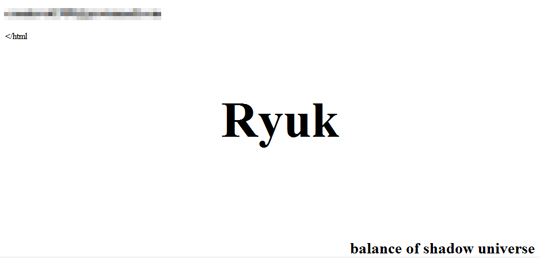Ransom.Win32.RYUK.WLDE
Trojan-Ransom.Ryuk(IKARUS)
Windows


Threat Type: Ransomware
Destructiveness: No
Encrypted:
In the wild: Yes
OVERVIEW
Dropped by other malware, Downloaded from the Internet
This Ransomware arrives on a system as a file dropped by other malware or as a file downloaded unknowingly by users when visiting malicious sites.
It drops files as ransom note. It avoids encrypting files with the following file extensions.
TECHNICAL DETAILS
128,512 bytes
EXE
Yes
16 Sep 2020
Terminates processes, Displays message/message boxes, Encrypts files
Arrival Details
This Ransomware arrives on a system as a file dropped by other malware or as a file downloaded unknowingly by users when visiting malicious sites.
Installation
This Ransomware drops the following copies of itself into the affected system and executes them:
- {Malware Directory}\{9 random characters}lan.exe → 3 copies with different random characters
It adds the following processes:
- icacls "{Drive Letter}:\*" /grant Everyone:F /T /C /Q → grants all users access to files and folders on the specified drive
- net stop {Service Name} /y
- taskkill /IM /F {Process Name}
Process Termination
This Ransomware terminates the following services if found on the affected system:
- vmcomp
- vmwp
- veeam
- Back
- xchange
- ackup
- acronis
- sql
- Enterprise
- Sophos
- Veeam
- AcrSch
- Antivirus
- bedbg
- DCAgent
- EPSecurity
- EPUpdate
- Eraser
- EsgSh
- Kernel
- FA_Scheduler
- IISAdmin
- IMAP4
- MBAM
- Endpoint
- Afee
- McShield
- task
- mfemms
- mfevtp
- mms
- MsDts
- Exchange
- ntrt
- PDVF
- POP3
- Report
- RESvc
- sacsvr
- SAVAdmin
- SamS
- SDRSVC
- SepMaster
- Monitor
- Smcinst
- Smc
- Service
- SMTP
- SNAC
- swi_
- CCSF
- TrueKey
- tmlisten
- UI0Detect
- W3S
- WRSVC
- NetMsmq
- ekrn
- EhttpSrv
- ESHASRV
- AVP
- klnagent
- wbengine
- KAVF
- mfefire
It terminates the following processes if found running in the affected system's memory:
- virtual
- vmcomp
- vmwp
- veeam
- backup
- Backup
- xchange
- sql
- dbeng
- sofos
- calc
- ekrn
- zoolz
- encsvc
- excel
- firefoxconfig
- infopath
- msaccess
- mspub
- mydesktop
- ocautoupds
- ocomm
- ocssd
- onenote
- oracle
- outlook
- powerpnt
- sqbcoreservice
- steam
- synctime
- tbirdconfig
- thebat
- thunderbird
- visio
- word
- xfssvccon
- tmlisten
- PccNTMon
- CNTAoSMgr
- Ntrtscan
- mbamtray
Other Details
This Ransomware does the following:
- It executes its 3 dropped copies with the following parameters:
- "{Malware Directory}\{9 random characters}lan.exe" 8 LAN → attempts to turn on devices in the network using Wake-on-Lan feature. If successful, it will encrypt the files in device's administrative share.
Ransomware Routine
This Ransomware avoids encrypting files with the following strings in their file name:
- ntldr
- bootmgr
- NTDETECT
- boot
It avoids encrypting files found in the following folders:
- \Windows\
- Windows
- boot
- WINDOWS
- Chrome
- Mozilla
- SYSVOL
- NTDS
- netlogon
- sysvol
It appends the following extension to the file name of the encrypted files:
- .RYK
It drops the following file(s) as ransom note:
- %User Temp%\RyukReadMe.html
- {Encrypted Directory}\RyukReadMe.html
- %Public%\RyukReadMe.html

It avoids encrypting files with the following file extensions:
- .dll
- .exe
- .ini
- .lnk
SOLUTION
9.850
16.252.06
27 Sep 2020
16.253.00
28 Sep 2020
Step 1
Before doing any scans, Windows 7, Windows 8, Windows 8.1, and Windows 10 users must disable System Restore to allow full scanning of their computers.
Step 2
Note that not all files, folders, and registry keys and entries are installed on your computer during this malware's/spyware's/grayware's execution. This may be due to incomplete installation or other operating system conditions. If you do not find the same files/folders/registry information, please proceed to the next step.
Step 3
Restart in Safe Mode
Step 4
Search and delete these files
- {Malware Directory}\{9 random characters}lan.exe
- {Malware Directory}\{9 random characters}lan.exe
- {Malware Directory}\{9 random characters}lan.exe
- %User Temp%\RyukReadMe.html
- {Encrypted Directory}\RyukReadMe.html
- %Public%\RyukReadMe.html
Step 5
Restart in normal mode and scan your computer with your Trend Micro product for files detected as Ransom.Win32.RYUK.WLDE. If the detected files have already been cleaned, deleted, or quarantined by your Trend Micro product, no further step is required. You may opt to simply delete the quarantined files. Please check this Knowledge Base page for more information.
Step 6
Restore encrypted files from backup.
Did this description help? Tell us how we did.

